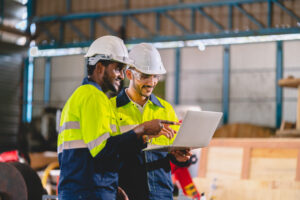Building Future Leaders through a Culture Committed to Safety and Mentorship
By David Frazier, Contributor
Beyond employing and equipping talent with strong skillsets, the core element of building a successful business is derived from the culture and role modeling demonstrated to your workforce. According to Forbes, companies with a robust culture have up to 72% higher employee engagement than those whose cultures are misaligned or need improvement.[1]
Right now, the construction industry is aging. Valuing a culture that enhances safety, mentorship, and well-being is essential to retaining top talent and recruiting professionals to keep the industry thriving.
As leaders, how can we further shape the future of construction through culture? This pressure can be lifted by dedicating the time to listen to employees’ voices, creating beneficial health and wellness programs, and investing the resources to mentor newcomers into our future leaders.
Employing Mentorship Programs
Experience is the cornerstone of success in the construction world. We must take action to empower newcomers to the industry and provide a path to success.
Hardaway Construction’s initiatives require new employees to begin our mentorship program as soon as they step on board. We begin with a personalized approach that pairs a newcomer with a leader, which creates the opportunity to learn each part of the business from an experienced mentor. From field-oriented quality assurance programs to office-based tasks, the training provides hands-on knowledge that forms the comprehension of construction work. This leadership program reflects our priority in investing time on the front end to empower our future leaders.
Beyond technical expertise, the “Hardaway Leadership Academy” continues our commitment to interpersonal skills as key to building relationships with partners within our company and externally. We focus on negotiation tactics, relationship building, and conflict resolution. These skills distinguish a good leader from a great one, and we’ve seen significant benefits to our culture and team member dedication.
Putting Employee Physical and Mental Well-being on a Pedestal
Our number one priority is our employees’ physical safety and mental health. To take action on this priority, we’ve implemented a Question, Persuade, Refer (QPR) training session, a program with approval from numerous organizations, including TSPN, TAADAS, TDMHSAS, and TDH. We’ve employed this program in-house through one of our employees who received a certification to teach the QPR training course. During each session, members participate in training designed to equip individuals with the skills and knowledge to help someone who may be considering suicide. We view the QPR training course as being as vital as CPR training, as it has the potential to save lives.
In addition to safety training, we also prioritize our employees’ health and well-being by offering reduced insurance premiums for those who proactively manage their health. This is a small gesture we can do to make each of our employee’s lives a bit easier and show our appreciation.
Ultimately, ensuring the safety and well-being of our construction team is a top priority, and these examples are just a few ways we demonstrate our commitment to this goal.
Encouraging Continued Growth and Education
Alongside our emphasis on mentorship and well-being, we also prioritize our employees’ ongoing education. We believe in the importance of encouraging employees to keep learning and growing to become the best versions of themselves.
This is why we have created an education policy that encourages workers to strive toward advanced degrees. We help them every step of the way, even financially, because we’re convinced that a commitment to learning is critical to helping our employees and company thrive.
Leading by Example for Our Future Leaders
Each of these initiatives can only come to fruition when we lead by example. Each requires proper leadership who enforces safety codes and acts as role models. As leaders, we must take it upon ourselves to implement safety protocols, build beneficial programs for our employees, and maintain moral integrity.
The construction industry faces significant challenges, including a shortage of skilled labor and increased project competition. However, we must never forget that our employees are our most valuable asset. It’s our duty to provide a healthy work environment and to prioritize safety for all.
David Frazier is the CEO and Owner, Hardaway Construction (hardaway.net).
[1] https://www.forbes.com/sites/paulamorgan/2022/08/19/understanding-the-importance-of-corporate-culture-after-the-great-resignation/?sh=6a3a5e8718cd





